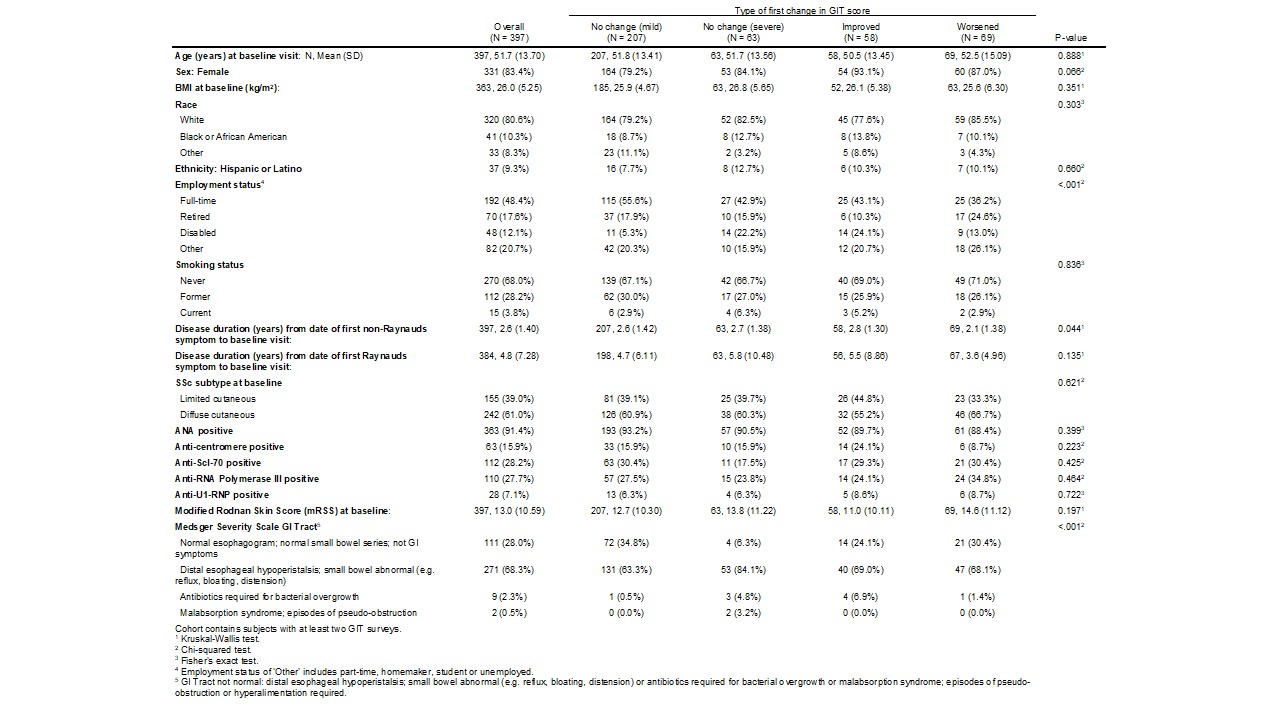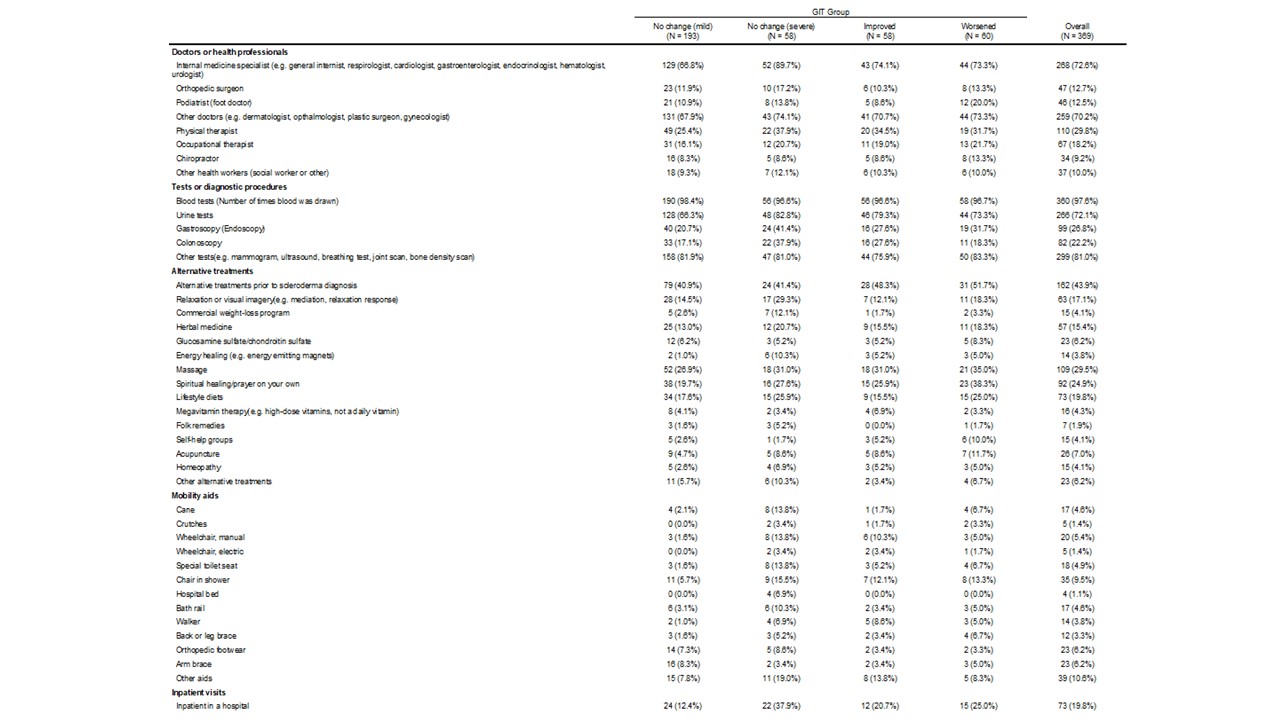Back
Poster Session B
Fibrosing rheumatic diseases (scleroderma, MCTD, IgG4-related disease, scleroderma mimics)
Session: (1046–1070) Systemic Sclerosis and Related Disorders – Clinical Poster I
1053: The Collaborative National Quality and Efficacy Registry for Scleroderma: Association of Resource Utilization and Gastrointestinal Tract Symptoms in Early Disease
Sunday, November 13, 2022
9:00 AM – 10:30 AM Eastern Time
Location: Virtual Poster Hall
- SL
Sarah Luebker, DO
Vanderbilt Medical University Cennter
Nashville, TN, United States
Abstract Poster Presenter(s)
Sarah Luebker1, Tracy Frech1, Shervin Assassi2, Jessica Gordon3, Elana Bernstein4, Virginia Steen5, Laura Hummers6, Ami Shah7, Carrie Richardson8, Dinesh Khanna9, Flavia Castelino10, Lorinda Chung11, Faye Hant12, Vicki Shanmugam13, John VanBuren14, Jessica Alvey14, Monica Harding14, Luke Evnin15 and Nora Sandorfi16, 1Vanderbilt University Medical Center, Nashville, TN, 2McGovern Medical School, University of Texas, Houston, TX, 3Hospital for Special Surgery, New York, NY, 4Columbia University, New York, NY, 5Georgetown University School of Medicine, Washington, DC, 6Johns Hopkins Univerisity, Baltimore, MD, 7Johns Hopkins Rheumatology, Baltimore, MD, 8Northwestern University, Chicago, IL, 9Division of Rheumatology, Department of Internal Medicine, Scleroderma Program, University of Michigan, Ann Arbor, MI, 10Massachusetts General Hospital, Boston, MA, 11Stanford University, Stanford, CA, 12Medical University of South Carolina, Charleston, SC, 13George Washington University, Washington, DC, 14University of Utah, Salt Lake City, UT, 15Scleroderma Research Foundation, Brisbane, CA, 16University of Pennsylvania, Philadelphia, PA
Background/Purpose: Health costs and resource utilization are important in chronic disease management. Systemic sclerosis (SSc) is a multi-organ system disease with outcomes that are often measured in terms of pulmonary, cardiovascular, or renal outcomes. However, the gastrointestinal tract (GIT) is the most frequently extra-cutaneous organ involved in SSc and a significant source of morbidity for patients. Resource utilization has not been examined in terms of GIT symptoms in SSc. This project examines the association of resource utilization with GIT symptoms in the Collaborative National Quality and Efficacy Registry (CONQUER) registry.
Methods: The inclusion criteria for this project included CONQUER participants that had completed a minimum of two serial Scleroderma Clinical Trials Consortium University of California Los Angeles Gastrointestinal Tract Questionnaire (GIT 2.0) and the resource utilization questionnaire (RUQ). Patients were categorized by total GIT 2.0 severity category change: none-to-mild (0.49); moderate (0.50-1.00), and severe-to-very severe (1.01-3.00) at baseline and at the subsequent visit. Four subsequent categories were created: no change (none-to-mild), improvement in category, worsening in category, and no change (moderate-to-severe). The RUQ includes information on visits to health professionals, diagnostic procedures, purchased aids, alternative treatments, outpatient procedures and surgeries, hospitalizations, rehabilitation or nursing home admission, time spent seeing physicians or other health professionals and medical tests, and need of an accompanying person.
Results: At the time of data analysis on May 4, 2022, there were 399 enrolled CONQUER participants that met project inclusion criteria. The sociodemographic and disease characteristics of those 399 participants categorized by change in GIT symptoms are shown in Table 1. Most participants (n=208, 52%) had stable mild GIT symptoms at all observed clinical assessments. The presence of digital ulcers and GAVE was not associated with GIT change category. As shown in Table 2, the participants with persistently severe GIT symptoms used the most resources, specifically visits to health professionals, endoscopy, colonoscopy, mobility aids, and inpatient hospitalization.
Conclusion: The RUQ informs the impact of SSc on direct medical costs. Our project demonstrated that GIT symptoms that are persistently worse occur equally in limited and diffuse SSc and regardless of antibody subtype. Improvement in GIT symptoms can result in less resource utilization and is an important focus for CONQUER.
 Patient Characteristics by GIT score
Patient Characteristics by GIT score
 Summary of Resource Utilization by GIT Group Change
Summary of Resource Utilization by GIT Group Change
Disclosures: S. Luebker, None; T. Frech, None; S. Assassi, Boehringer-Ingelheim, Janssen, Novartis, AstraZeneca, CSL Behring, AbbVie/Abbott; J. Gordon, None; E. Bernstein, None; V. Steen, None; L. Hummers, Boehringer-Ingelheim, Corbus Pharmaceuticals, Cumberland Pharmaceuticals, Kadmon Corporation, Medpace, CSL Behring, Mitsubishi Tanabe, Horizon Pharmaceuticals; A. Shah, Arena Pharmaceuticals, Medpace/Eicos, Kadmon Corporation; C. Richardson, None; D. Khanna, Boehringer Ingelheim, Genentech, Prometheus, Horizon, Chemomab, Talaris, Gesynta, Amgen, Acceleron, Actelion, Bayer, CSL Behring, Paracrine Cell Therapy, Mitsubishi Tanabe, Theraly, Eicos Sciences; F. Castelino, Boehringer-Ingelheim; L. Chung, None; F. Hant, None; V. Shanmugam, None; J. VanBuren, None; J. Alvey, None; M. Harding, None; L. Evnin, None; N. Sandorfi, None.
Background/Purpose: Health costs and resource utilization are important in chronic disease management. Systemic sclerosis (SSc) is a multi-organ system disease with outcomes that are often measured in terms of pulmonary, cardiovascular, or renal outcomes. However, the gastrointestinal tract (GIT) is the most frequently extra-cutaneous organ involved in SSc and a significant source of morbidity for patients. Resource utilization has not been examined in terms of GIT symptoms in SSc. This project examines the association of resource utilization with GIT symptoms in the Collaborative National Quality and Efficacy Registry (CONQUER) registry.
Methods: The inclusion criteria for this project included CONQUER participants that had completed a minimum of two serial Scleroderma Clinical Trials Consortium University of California Los Angeles Gastrointestinal Tract Questionnaire (GIT 2.0) and the resource utilization questionnaire (RUQ). Patients were categorized by total GIT 2.0 severity category change: none-to-mild (0.49); moderate (0.50-1.00), and severe-to-very severe (1.01-3.00) at baseline and at the subsequent visit. Four subsequent categories were created: no change (none-to-mild), improvement in category, worsening in category, and no change (moderate-to-severe). The RUQ includes information on visits to health professionals, diagnostic procedures, purchased aids, alternative treatments, outpatient procedures and surgeries, hospitalizations, rehabilitation or nursing home admission, time spent seeing physicians or other health professionals and medical tests, and need of an accompanying person.
Results: At the time of data analysis on May 4, 2022, there were 399 enrolled CONQUER participants that met project inclusion criteria. The sociodemographic and disease characteristics of those 399 participants categorized by change in GIT symptoms are shown in Table 1. Most participants (n=208, 52%) had stable mild GIT symptoms at all observed clinical assessments. The presence of digital ulcers and GAVE was not associated with GIT change category. As shown in Table 2, the participants with persistently severe GIT symptoms used the most resources, specifically visits to health professionals, endoscopy, colonoscopy, mobility aids, and inpatient hospitalization.
Conclusion: The RUQ informs the impact of SSc on direct medical costs. Our project demonstrated that GIT symptoms that are persistently worse occur equally in limited and diffuse SSc and regardless of antibody subtype. Improvement in GIT symptoms can result in less resource utilization and is an important focus for CONQUER.
 Patient Characteristics by GIT score
Patient Characteristics by GIT score  Summary of Resource Utilization by GIT Group Change
Summary of Resource Utilization by GIT Group Change Disclosures: S. Luebker, None; T. Frech, None; S. Assassi, Boehringer-Ingelheim, Janssen, Novartis, AstraZeneca, CSL Behring, AbbVie/Abbott; J. Gordon, None; E. Bernstein, None; V. Steen, None; L. Hummers, Boehringer-Ingelheim, Corbus Pharmaceuticals, Cumberland Pharmaceuticals, Kadmon Corporation, Medpace, CSL Behring, Mitsubishi Tanabe, Horizon Pharmaceuticals; A. Shah, Arena Pharmaceuticals, Medpace/Eicos, Kadmon Corporation; C. Richardson, None; D. Khanna, Boehringer Ingelheim, Genentech, Prometheus, Horizon, Chemomab, Talaris, Gesynta, Amgen, Acceleron, Actelion, Bayer, CSL Behring, Paracrine Cell Therapy, Mitsubishi Tanabe, Theraly, Eicos Sciences; F. Castelino, Boehringer-Ingelheim; L. Chung, None; F. Hant, None; V. Shanmugam, None; J. VanBuren, None; J. Alvey, None; M. Harding, None; L. Evnin, None; N. Sandorfi, None.

